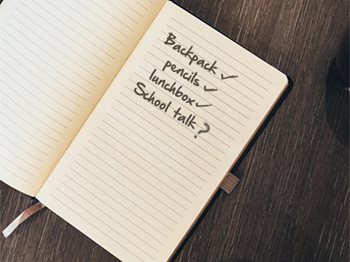From Hanen.org
By Lauren Lowry
Hanen Certified SLP and Clinical Staff Writer
Being prepared for school involves a lot more than going to the store to buy a lunchbox and a backpack. There are many skills that children need to be able to function in a classroom and understand the curriculum. Children learn many of these skills at home as they interact with their parents and siblings. For example, they learn to express themselves well, understand directions, follow daily routines, listen to and tell stories, have conversations, and use their imagination.
But success at school also depends on being able to understand and use “school talk”, a special type of talk that is used in the classroom. Also known as “academic talk” and “classroom discourse” , school talk is quite different from the type of language children hear during everyday life at home, which is known as “casual talk”.
In order to help children understand and use school talk, teachers and SLPs can:
- Make school talk explicit
One important way to promote school talk is to make it explicit by explaining the school talk expectations required before engaging in an activity. For example, a teacher might highlight the way she will ask questions that test the children’s knowledge by saying “Because we are in school, I’m going to ask you some questions I already know the answer to. This helps me know if I’m doing a good job teaching you. If you don’t know the answer, that’s okay. Maybe someone else will know the answer.” Teachers can also explain how children can make an educated guess when they are unsure of an answer, saying something like, “Sometimes you might not know the answer, but you can think about what the answer might be and let us know what you are thinking.” - Use “think alouds”
“Think alouds” involve putting one’s thought process into words. Teachers can use think alouds to demonstrate the thought process involved in some aspects of school talk. For example, a think aloud which demonstrates how to think of an answer to a question might be: “I wonder who this book is going to be about? I am going to use the front cover to look for hints to guess who it’s about…” . Teachers can also use think alouds to explain how to make a guess, such as, “There’s a picture of a bear and a bird on the cover, so maybe the book is about one of those animals.” - Use meaningful activities
It’s easiest to teach children about school talk while they are engaged in a meaningful activity during which school talk is used, such as Show and Tell and book sharing
It’s easiest to teach children about school talk while they are engaged in a meaningful activity during which school talk is used, such as Show and Tell and book sharing :
- Show and Tell
Show and Tell involves the child discussing personal experiences with the class via an explanation that is often guided by the teacher through comments and questions. In this way, the teacher guides the child’s casual talk about his or her personally relevant item towards talk that is closer to school talk. Before starting Show and Tell, the teacher can clearly describe the expectations to the children, saying something like “When you talk about your special rock in school, you may quickly tell us why it is special to you, but then we also want to talk together about what kind of rock it is…That way, we can use your special rock to learn about lots of rocks. I’ll help you by asking you some questions as you tell us about your special rock” . - Book sharing
Sharing books in preschool offers a good opportunity to model some of the more complex language and thinking required in school talk. Teachers can use and explain new, unfamiliar vocabulary, ask questions and make comments that help the children make connections between the story and their own experiences, and help children think beyond the pages of the book.
- Show and Tell


Recent Comments